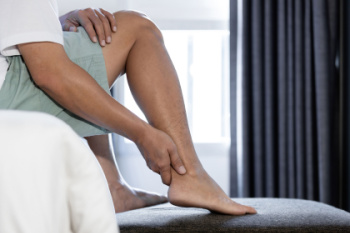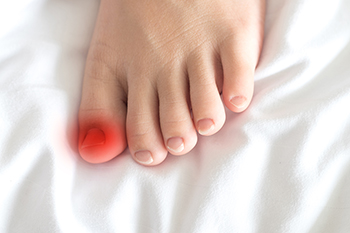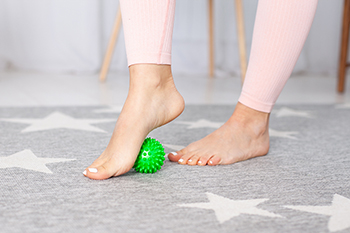Items filtered by date: March 2025
Common Injuries That Affect the Achilles Tendon

The Achilles tendon is the largest tendon in the body and is essential for walking, running, and jumping. Unfortunately, it is also prone to several common injuries. Achilles tendinitis occurs when the tendon becomes inflamed from overuse or repetitive stress, often causing pain and stiffness at the back of the ankle. Another injury is Achilles tendinosis, which involves degeneration and thickening of the tendon over time. More serious injuries include partial tears or a complete rupture of the tendon, which can happen suddenly during sports or physical activity. Symptoms of Achilles injuries include pain, swelling, tenderness, and difficulty walking. Ignoring early warning signs can lead to more serious problems. If you are experiencing Achilles tendon pain, it is suggested that you see a podiatrist for a proper diagnosis and appropriate treatment.
Achilles tendon injuries need immediate attention to avoid future complications. If you have any concerns, contact one of our podiatrists of Pocono Foot & Ankle Consultants. our doctors can provide the care you need to keep you pain-free and on your feet.
What Is the Achilles Tendon?
The Achilles tendon is a tendon that connects the lower leg muscles and calf to the heel of the foot. It is the strongest tendon in the human body and is essential for making movement possible. Because this tendon is such an integral part of the body, any injuries to it can create immense difficulties and should immediately be presented to a doctor.
What Are the Symptoms of an Achilles Tendon Injury?
There are various types of injuries that can affect the Achilles tendon. The two most common injuries are Achilles tendinitis and ruptures of the tendon.
Achilles Tendinitis Symptoms
- Inflammation
- Dull to severe pain
- Increased blood flow to the tendon
- Thickening of the tendon
Rupture Symptoms
- Extreme pain and swelling in the foot
- Total immobility
Treatment and Prevention
Achilles tendon injuries are diagnosed by a thorough physical evaluation, which can include an MRI. Treatment involves rest, physical therapy, and in some cases, surgery. However, various preventative measures can be taken to avoid these injuries, such as:
- Thorough stretching of the tendon before and after exercise
- Strengthening exercises like calf raises, squats, leg curls, leg extensions, leg raises, lunges, and leg presses
If you have any questions please feel free to contact our offices located in Stroudsburg, Nazareth, and Easton, PA . We offer the newest diagnostic tools and technology to treat your foot and ankle needs.
Causes and Risk Factors of Ingrown Toenails

An ingrown toenail develops when the edge of the nail grows into the surrounding skin, causing pain, redness, and swelling. This condition commonly affects the big toe and can lead to infection if not treated properly. Several factors increase the risk of developing ingrown toenails, including improper nail trimming, wearing tight or ill-fitting shoes, and sustaining toe injuries. Curved or thick nails may also contribute to the problem, making certain individuals more prone to ingrown toenails. Those with diabetes or circulation issues are at a higher risk of complications. Repeated pressure from activities like running or dancing can also aggravate the condition. Ingrown toenails can be painful, causing difficulty in completing daily tasks. If you have a painful ingrown toenail, it is suggested that you promptly consult a podiatrist who can offer you appropriate treatment solutions.
Ingrown toenails can become painful if they are not treated properly. For more information about ingrown toenails, contact one of our podiatrists of Pocono Foot & Ankle Consultants. our doctors can provide the care you need to keep you pain-free and on your feet.
Ingrown Toenails
Ingrown toenails occur when a toenail grows sideways into the bed of the nail, causing pain, swelling, and possibly infection.
Causes
- Bacterial infections
- Improper nail cutting such as cutting it too short or not straight across
- Trauma to the toe, such as stubbing, which causes the nail to grow back irregularly
- Ill-fitting shoes that bunch the toes too close together
- Genetic predisposition
Prevention
Because ingrown toenails are not something found outside of shoe-wearing cultures, going barefoot as often as possible will decrease the likeliness of developing ingrown toenails. Wearing proper fitting shoes and using proper cutting techniques will also help decrease your risk of developing ingrown toenails.
Treatment
Ingrown toenails are a very treatable foot condition. In minor cases, soaking the affected area in salt or antibacterial soaps will not only help with the ingrown nail itself, but also help prevent any infections from occurring. In more severe cases, surgery is an option. In either case, speaking to your podiatrist about this condition will help you get a better understanding of specific treatment options that are right for you.
If you have any questions please feel free to contact our offices located in Stroudsburg, Nazareth, and Easton, PA . We offer the newest diagnostic and treatment technologies for all your foot and ankle needs.
See Your Foot Specialist Regularly If You Work On Your Feet
Common Foot Injuries in Runners

Running places significant stress on the feet, toes, and ankles, often leading to injuries, including plantar fasciitis, ankle sprains, metatarsal stress fractures, and Morton’s neuroma. Plantar fasciitis involves inflammation of the plantar fascia, which is the thick band of tissue connecting the heel to the toes. It causes heel pain, especially upon waking or after prolonged activity. Ankle sprains occur when ligaments are overstretched or torn due to twisting motions, which results in swelling, bruising, and instability. Metatarsal stress injuries, frequently caused by rapid increases in running intensity, involve inflammation or stress fractures of the bones that connect the ankle to the toes. This causes pain, swelling, or tenderness in the foot. Morton’s neuroma is caused by thickened tissue surrounding nerves, typically between the third and fourth toes. It results in a sensation similar to having a pebble in the shoe, accompanied by burning pain or numbness. If you are experiencing foot pain after running, it is suggested that you schedule an appointment with a podiatrist for an exam, diagnosis, and treatment.
All runners should take extra precaution when trying to avoid injury. If you have any concerns about your feet, contact one of our podiatrists of Pocono Foot & Ankle Consultants. our doctors will treat your foot and ankle needs.
How to Prevent Running Injuries
There are a lot of mistakes a runner can make prior to a workout that can induce injury. A lot of athletes tend to overstretch before running, instead of saving those workouts for a post-run routine. Deep lunges and hand-to-toe hamstring pulls should be performed after a workout instead of during a warmup. Another common mistake is jumping into an intense routine before your body is physically prepared for it. You should try to ease your way into long-distance running instead of forcing yourself to rush into it.
More Tips for Preventing Injury
- Incorporate Strength Training into Workouts - This will help improve the body’s overall athleticism
- Improve and Maintain Your Flexibility – Stretching everyday will help improve overall performance
- “Warm Up” Before Running and “Cool Down” Afterward – A warm up of 5-10 minutes helps get rid of lactic acid in the muscles and prevents delayed muscle soreness
- Cross-Training is Crucial
- Wear Proper Running Shoes
- Have a Formal Gait Analysis – Poor biomechanics can easily cause injury
If you have any questions, please feel free to contact our offices located in Stroudsburg, Nazareth, and Easton, PA . We offer the newest diagnostic and treatment technologies for all your foot care needs.
Foot and Ankle Exercises Can Help Diabetic Patients

A foot and ankle exercise program can make a significant difference for individuals with diabetic neuropathy, a condition that often impairs nerve function and affects mobility. Targeted exercises can strengthen muscles, enhance flexibility, and improve joint stability, which can collectively boost gait speed and overall walking ability. By focusing on areas weakened by neuropathy, these programs help restore balance and coordination, reducing the risk of falls and fostering greater confidence in movement. Such exercises also support better circulation in the lower limbs, which is vital for managing diabetes-related complications. When combined with other treatments, including medication and wearing proper footwear, a therapeutic exercise routine offers a holistic approach to improving mobility and foot health. For tailored care and expert guidance on a personalized exercise program, it is suggested that you consult a podiatrist.
Exercising your feet regularly with the proper foot wear is a great way to prevent injuries and build strength. If you have any concerns about your feet, contact one of our podiatrists from Pocono Foot & Ankle Consultants. our doctors can provide the care you need to keep you pain-free and on your feet.
Exercise for Your Feet
Exercise for your feet can help you gain strength, mobility and flexibility in your feet. They say that strengthening your feet can be just as rewarding as strengthening another part of the body. Your feet are very important, and we often forget about them in our daily tasks. But it is because of our feet that are we able to get going and do what we need to. For those of us fortunate enough to not have any foot problems, it is an important gesture to take care of them to ensure good health in the long run.
Some foot health exercises can include ankle pumps, tip-toeing, toe rises, lifting off the floor doing reps and sets, and flexing the toes. It is best to speak with our doctors to determine an appropriate regimen for your needs. Everyone’s needs and bodies are different, and the activities required to maintain strength in the feet vary from individual to individual.
Once you get into a routine of doing regular exercise, you may notice a difference in your feet and how strong they may become.
If you have any questions please feel free to contact our offices located in Stroudsburg, Nazareth, and Easton, PA . We offer the newest diagnostic and treatment technologies for all your foot and ankle needs.

